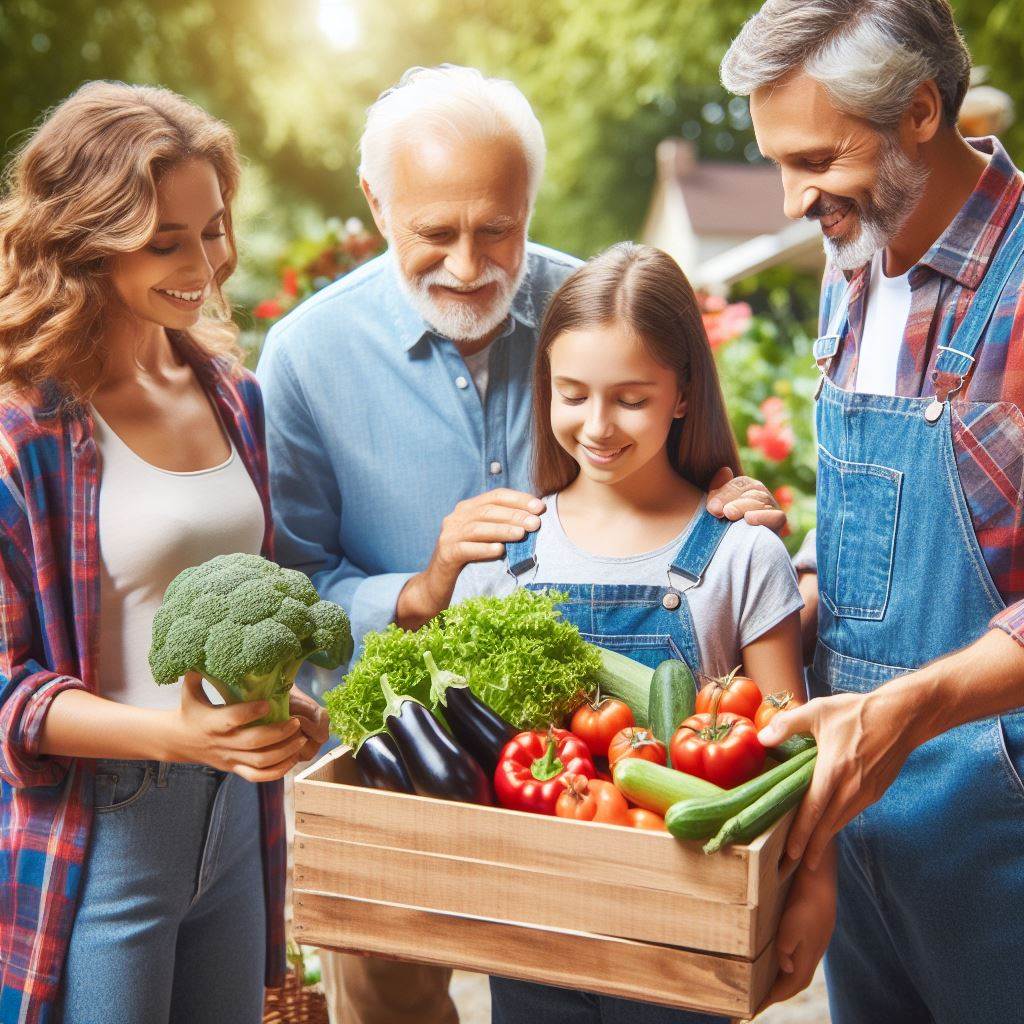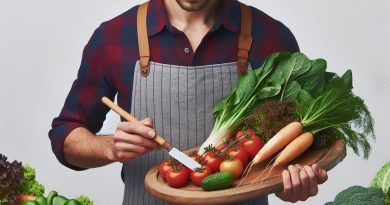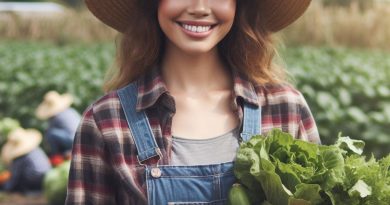CSA Boxes: What to Expect
Last Updated on March 2, 2024
Introduction
CSA boxes, or Community Supported Agriculture boxes, are packages of fresh produce and other food items.
Knowing what to expect is important because it helps in meal planning and reduces food waste.
By understanding the contents of the CSA box, individuals can plan their meals, try new recipes, and support local farmers.
Additionally, being aware of what to expect helps in maintaining a balanced diet by making sure there is a variety of fruits, vegetables, and other food groups.
Not knowing what to expect can lead to disappointment or confusion when receiving the CSA box.
It is important to read the descriptions and guidelines provided by the CSA farm to have realistic expectations.
CSA boxes are seasonal, so the contents will vary based on the time of year.
They typically include a mix of fruits and vegetables, but can also include other items like eggs, meat, or even flowers.
Some farms provide recipe suggestions or meal plans along with the CSA boxes to assist in utilizing the produce effectively.
CSA boxes are a great way to support local agriculture and have a direct connection with the food production process.
By knowing what to expect, individuals can fully enjoy the benefits of CSA boxes and make the most of their fresh, locally sourced produce.
What is a CSA box?
A CSA box, short for Community Supported Agriculture, is a subscription-based program where consumers receive a weekly box of fresh, locally sourced produce and other products.
Explanation of CSA (Community Supported Agriculture)
CSA is a system that allows consumers to directly support local farmers by paying in advance for a share of their seasonal harvest.
By participating in a CSA program, consumers become members of a farm community, sharing both the benefits and risks of agriculture.
They build a direct relationship with their farmers and have a deeper connection to the food they consume.
CSA box contents
CSA boxes can vary in size and content depending on the farm and the region. However, most boxes typically include:
- Fresh produce: Farm-fresh fruits and vegetables are the mainstay of CSA boxes. Members enjoy a variety of seasonal, organic, and locally grown produce, often harvested at peak ripeness for optimal taste and nutrition.
- Herbs: CSA boxes may also include a selection of fresh herbs such as basil, parsley, thyme, or cilantro, adding flavor and aroma to homemade meals.
- Dairy products: Some CSA programs partner with local dairy farmers, offering members access to farm-fresh milk, cheese, yogurt, or butter.
- Eggs: Many CSA boxes include farm eggs, known for their vibrant yolks and superior taste compared to store-bought eggs.
- Meat: Some CSA programs have connections with local ranchers, offering members high-quality cuts of grass-fed beef, pork, chicken, or other meats.
- Other items (e.g., baked goods): In addition to the core products, CSA boxes can surprise members with other treats like homemade bread, fresh flowers, honey, or locally made preserves.
CSA boxes are often customizable, allowing members to tailor their deliveries to suit their preferences or dietary needs.
For example, some programs have options for vegetarian or gluten-free boxes.
Overall, CSA boxes provide a convenient and sustainable way for consumers to access fresh, local, and seasonal produce while supporting their local farming communities.
Read: CSA: Supporting Local Farms
Benefits of CSA Boxes
Supporting local farmers
- CSA boxes provide direct support to local farmers by purchasing their produce.
- Supporting local farmers helps to build a strong and sustainable community.
- It allows farmers to receive fair prices for their products and encourages their continued growth.
- CSA subscriptions ensure a reliable and consistent market for local farmers, giving them financial security.
- By supporting local farmers, consumers can contribute to preserving agricultural lands and rural livelihoods.
Access to fresh, seasonal produce
- CSA boxes allow consumers to have access to the freshest and highest quality produce available.
- Since the produce is harvested closer to the delivery date, it retains more nutrients and flavor.
- Consumers can enjoy a variety of fruits, vegetables, and other products that are in season.
- Eating seasonal produce provides a range of different nutrients, promoting a healthy and balanced diet.
- CSA boxes often include unique and heirloom varieties that are not commonly found in supermarkets.
Promoting sustainable farming practices
- CSA boxes promote environmentally-friendly farming practices, such as organic and regenerative agriculture.
- Local farmers who participate in CSA programs often prioritize sustainable and ethical farming methods.
- These practices reduce the use of synthetic fertilizers and pesticides, benefiting the environment and human health.
- CSA models also encourage the use of crop rotation and biodiversity, promoting natural pest control.
- Supporting sustainable farming practices helps to protect soil health and preserve ecosystems for future generations.
In short, CSA boxes offer numerous benefits for both consumers and local farmers.
By subscribing to a CSA program, individuals can support local farmers directly, helping to build a resilient and sustainable community.
They also gain access to fresh, seasonal produce that is packed with nutrients and flavor.
Furthermore, CSA boxes promote environmentally-friendly farming practices, contributing to the preservation of the environment and human health.
Embracing CSA boxes is a win-win situation, as it benefits both consumers and local farmers while fostering a more sustainable food system.
Read: CSA & Food Security Links
How to join a CSA program
Finding a local CSA farm
- Start by researching local CSA farms in your area using online directories or local agriculture organizations.
- Consider the distance and accessibility of the CSA farm, as you will need to pick up your CSA box regularly.
- Read reviews or ask for recommendations from friends or family members who have joined CSA programs before.
Understanding pricing options
- Different CSA farms may offer different pricing options, depending on the size of the CSA box and the length of the subscription.
- Take into account your budget and the quantity of produce you and your family can consume when choosing a pricing option.
- Some CSA farms may also provide add-ons or extras, such as eggs, honey, or flowers, which may incur additional costs.
Sign-up process
- Once you have found a CSA farm that suits your preferences, visit their website or contact them directly to inquire about sign-up.
- Most CSA farms have a specific sign-up period, so make sure to check the deadlines and availability.
- Some CSA farms require a membership fee or a deposit upon sign-up, so be prepared to make this payment.
- Fill out the necessary forms or submit the required information, such as your contact details and any dietary restrictions.
- If there is limited availability, ensure you secure your spot by signing up as soon as possible.
- Review the terms and conditions of the CSA program, including the pick-up location, schedule, and any additional rules or requirements.
- Ensure you understand the commitment involved in joining a CSA program, as some farms may not offer refunds or cancellations once you have signed up.
- If you have any questions or concerns, do not hesitate to reach out to the CSA farm for clarification.
- Once you have completed the sign-up process, you will receive further instructions regarding the pick-up of your CSA box.
- Make sure to mark the pick-up dates on your calendar and set reminders to ensure you do not miss any distributions.
- Consider sharing the experience with friends or neighbors and encourage them to join the CSA program as well.
In summary, joining a CSA program involves finding a local CSA farm, understanding pricing options, and completing the sign-up process.
By following these steps, you can become a part of a community-supported agriculture program and enjoy fresh, locally sourced produce delivered straight to your doorstep.
Read: Seasonal Eating via CSA
What to Expect in Your CSA Box
Variety of Produce
When you sign up for a CSA box, you can expect a wide range of fresh, local produce.
- Freshly picked fruits like apples, oranges, berries, and melons.
- An assortment of vegetables such as tomatoes, onions, lettuce, carrots, and cucumbers.
- Herbs like basil, cilantro, parsley, and thyme to enhance your dishes with flavor.
Seasonal Rotation
CSA boxes provide seasonal produce, so you can expect a continuous rotation of fruits and vegetables throughout the year.
- In spring, you may receive tender greens, strawberries, and peas.
- Summer brings an abundance of tomatoes, sweet corn, zucchini, and watermelon.
- Fall introduces hearty squash, pumpkins, apples, and Brussels sprouts.
- Winter offers root vegetables like potatoes, turnips, and beets, perfect for comforting soups.
Challenges of Unexpected Items
CSA boxes often come with surprises, and you may encounter unfamiliar or unexpected items.
- Unusual fruits or vegetables like kohlrabi or celeriac can present a cooking challenge.
- Unique varieties of common produce, such as heirloom tomatoes, require different handling.
- Embrace the opportunity to try new things and experiment with unfamiliar ingredients.
Adjusting Cooking Plans
Since CSA boxes are unpredictable, you may need to adjust your cooking plans accordingly.
- Be flexible and creative when it comes to meal planning to accommodate varying produce.
- Try different cooking methods like roasting, steaming, or grilling to make the most of your ingredients.
- Consider preserving extras through freezing, canning, or pickling to avoid waste.
In general, a CSA box promises a diverse selection of fresh, seasonal produce, along with the occasional surprise.
It’s an opportunity to expand your culinary horizons and become more creative in the kitchen.
Embrace the challenges and enjoy the delicious fruits and vegetables that come your way!
Read: Organic Food & CSA Impact

Tips for making the most of your CSA box
Meal planning and menu adjustments
- Assess the contents of your CSA box and plan meals around the freshest produce.
- Get creative and experiment with different recipes to incorporate all the ingredients.
- Make a list of additional ingredients needed to complete your meals and reduce food waste.
- Consider adjusting your weekly menu based on the contents of the box to fully utilize the produce.
Sharing with family, friends, or neighbors
- If you receive more produce than you can consume, share it with others to prevent waste.
- Coordinate with friends, family, or neighbors who may be interested in splitting the cost of a CSA box.
- Create a sharing system where everyone takes turns keeping the box for a week and shares the produce.
Trying new recipes
- CSA boxes often contain unique or unfamiliar produce, giving you the opportunity to try new recipes.
- Explore online resources, cookbooks, or cooking apps for recipes that highlight the box’s contents.
- Challenge yourself to step out of your culinary comfort zone and discover new flavors and dishes.
- Share your favorite recipes using CSA produce with the CSA community or on social media platforms.
Preserving surplus produce for later
- If you have surplus produce that you can’t consume immediately, consider preserving it for later use.
- Freezing, canning, pickling, or dehydrating are excellent methods to extend the shelf life of produce.
- Research proper preservation techniques to ensure the best quality and flavor when using preserved produce.
- Plan ahead and preserve certain items during peak season to enjoy them during off-peak months.
By following these tips, you can maximize the benefits of your CSA box:
- Create delicious meals while minimizing food waste
- Foster community spirit by sharing with others
- Expand your culinary horizons by trying new recipes
- Enjoy fresh, seasonal produce even beyond the CSA box’s delivery timeframe
Remember, CSA boxes are not just a delivery of produce, but an opportunity to support local farmers, eat sustainably, and nourish yourself and your loved ones with wholesome, fresh ingredients.
See Related Content: Expert Talks on Sustainable Eating in 2024
Explore Further: The Eco-Impact of Organic Food Choices
Handling and Storage of CSA Box Contents
Properly Cleaning Fruits and Vegetables
- Fill a clean sink or container with cold water to wash the fruits and vegetables.
- Gently scrub the produce using a soft brush or your hands to remove any dirt or debris.
- Rinse the fruits and vegetables thoroughly under running water to remove any remaining traces of dirt.
- Dry the produce by using a clean towel or salad spinner before storing them in the refrigerator.
Storing Differently Perishable Items
- Separate fruits and vegetables to prevent them from ripening or spoiling quickly.
- Store leafy greens, herbs, and delicate fruits and vegetables in plastic bags with holes to allow for airflow.
- Keep root vegetables like carrots, potatoes, and beets in a cool, dark place like a pantry or basement.
- Store hardy fruits such as apples, oranges, and melons at room temperature, away from direct sunlight.
- Always check for any signs of spoilage or rot, and remove those items from your storage.
Utilizing Preservation Methods (e.g., Canning, Freezing)
- Canning: Prepare the fruits or vegetables by washing and cutting them into desired sizes.
- Place them in sterilized canning jars and process them according to proper canning instructions.
- Freezing: Blanch the vegetables briefly in boiling water, then transfer them to ice water to cool rapidly.
- Pack the cooled vegetables into airtight freezer bags or containers and freeze them immediately.
- Consider making homemade sauces, jams, or pickles with surplus produce to extend their shelf life.
- Label all your preserved items with the date and content to keep track of their freshness.
Therefore, proper handling and storage of CSA box contents can significantly prolong their freshness and nutritional value.
By cleaning fruits and vegetables appropriately, storing them based on perishability, and utilizing preservation methods like canning or freezing, you can ensure that you enjoy the full benefits of your CSA box throughout the week.
Remember to regularly check for spoilage and remove any affected items to prevent contamination.
Get creative with preserving surplus produce to avoid waste and savor their flavors even after the harvesting season.
Maximize the value of your CSA box by handling and storing its contents effectively.
Frequently asked questions (FAQs)
CSA boxes have become increasingly popular in recent years as people are more conscious about the food they consume and where it comes from.
These boxes provide a convenient way to support local farmers and enjoy fresh, seasonal produce.
However, if you are new to CSA boxes, you may have some questions.
In this section, we will address some frequently asked questions (FAQs) to help you better understand what to expect.
How often are CSA boxes delivered?
- CSA boxes are typically delivered on a weekly basis.
- This ensures that you receive a regular supply of fresh produce throughout the growing season.
- It also allows farmers to plan their harvest and distribution accordingly.
Can I customize my CSA box?
- Yes, many CSA programs offer customization options where you can choose the items you want.
- This is particularly helpful if you have dietary restrictions or preferences.
- Some CSA farms even allow you to swap certain items for others.
What if I don’t like a certain type of produce?
- CSA boxes usually come with a variety of produce, including both familiar and lesser-known items.
- However, if there is something you don’t like or know how to use, you can often request a substitution.
- CSA farmers are usually happy to accommodate your preferences within reason.
What if I am going on vacation?
- If you are going on vacation, you may be concerned about receiving a CSA box that you won’t be able to use.
- However, most CSA programs allow you to pause your delivery while you’re away.
- Some even offer the option to have your box delivered to a different address, such as a friend or family member’s house.
Ultimately, CSA boxes are a fantastic way to support local farmers and enjoy a variety of fresh, seasonal produce.
By understanding the frequency of deliveries, customization options, and flexibility during vacations, you can fully maximize the benefits of your CSA box subscription.
Conclusion
CSA boxes offer a unique farm-to-table experience, connecting consumers with local, seasonal produce.
Embrace the surprises that CSA boxes bring—each delivery unfolds a delightful assortment of fresh, diverse, and flavorful items.
By trying CSA boxes, you not only enjoy the benefits of high-quality, locally sourced produce but also support sustainable agriculture practices.
To embark on this culinary journey, consider reaching out to local CSA farms or exploring online resources.
For local CSA options or information on getting started, connect with nearby farms or utilize online directories.
This direct connection with local farmers not only ensures a steady supply of fresh and seasonal produce but also fosters a sense of community and environmental responsibility.
As you navigate your way through the world of CSA boxes, remember that each box is a step towards sustainable living, supporting local agriculture, and enjoying the delicious rewards of seasonal eating.
So, whether you’re a seasoned supporter of CSA or a newcomer, consider exploring the rich offerings of your local farms through CSA boxes.
It’s a culinary adventure that not only tantalizes your taste buds but also nurtures a healthier and more sustainable relationship with the food on your plate.


